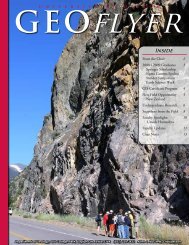Stander Symposium abstract book - University of Dayton
Stander Symposium abstract book - University of Dayton
Stander Symposium abstract book - University of Dayton
Create successful ePaper yourself
Turn your PDF publications into a flip-book with our unique Google optimized e-Paper software.
POSTER SESSION 1<br />
Lobe (L) interacts genetically with RD factors to promote ectopic eye formation in<br />
Drosophila melanogaster<br />
Presenter(s):<br />
Advisor(s): Madhuri Kango-Singh, Amit Singh<br />
Biology - Independent Research<br />
The Drosophila gene Lobe (L) is required for cell survival, Dorsoventral (DV) patterning, and eye development. L mutants cause loss-<strong>of</strong>-ventral eye<br />
phenotype due to induction <strong>of</strong> cell death and upregulation <strong>of</strong> Wingless (Wg). We investigated the role <strong>of</strong> L in eye development and specifically<br />
evaluate its ability to modulate the activity <strong>of</strong> the Retinal Determination Gene Network (RDGN). Specifically, we modulated L levels and assayed<br />
the effects on Ey, Eya, and So mediated ectopic eye induction using the UAS/GAL 4 misexpression system. Our results confirm that targeted<br />
expression <strong>of</strong> Ey induces ectopic eyes at a higher frequency. Among different Ey stocks tested for their ability to rescue the half eye phenotype <strong>of</strong><br />
L2 mutation were full length Ey (UAS Ey#10 and UAS Ey#11) and others that had mutations in the phosphorylation sites in the CTD. UAS Ey Dala<br />
#2 is the most potent inducer <strong>of</strong> ectopic eyes. Furthermore, misexpression <strong>of</strong> eya or So result in the formation <strong>of</strong> smaller ectopic eyes at a lower<br />
frequency. The Eya protein levels remain unchanged in the bi;L2 >UAS Eya crosses suggesting that Eya is upstream <strong>of</strong> L. We hypothesized that if<br />
L genetically interacts with the key components <strong>of</strong> RDGN, co-expression <strong>of</strong> L with bi;GAL4> Ey, Eya, So, Eya+So would result in an expansion <strong>of</strong><br />
eye field with tissue overgrowth in the eye-antennal disc. We also tested the requirement for L in inducing ectopic eyes by the key components <strong>of</strong><br />
RDGN. We found that ectopic eyes are formed more robustly (increase in number and size) in the presence <strong>of</strong> L than in its absence.Misexpressing<br />
Eya, So, or both causes increased pharate lethality (>95%), distortion <strong>of</strong> compound eye at its margins, and partially rescues the loss <strong>of</strong> ventral eye<br />
phenotype <strong>of</strong> L2 mutant suggesting a genetic interaction.<br />
PCL Nan<strong>of</strong>ibers Induce Lens Fiber Formation <strong>of</strong> Mouse Lens Epithelial Cells<br />
Presenter(s): Joelle Baddour<br />
Advisor(s): Panagiotis A Tsonis<br />
Biology - Graduate Research<br />
Current cataractous lens replacement therapies require frequent medical checkups due to the potential formation <strong>of</strong> secondary cataracts as a<br />
result <strong>of</strong> the transdifferentiation <strong>of</strong> residual lens epithelial cells to mesenchymal my<strong>of</strong>ibroblast cells (EMT). To prevent EMT, current treatments<br />
include laser therapy or the administration <strong>of</strong> anti-fibrotic drugs. Recently, Poly-epsilon-caprolactone (PCL) has become a popular material for tissue<br />
replacement therapy due to its relative durability compared to other biomaterials. For instance, the use <strong>of</strong> PCL as a nan<strong>of</strong>ibrous scaffold <strong>of</strong>fers<br />
a novel tool to model the complex architecture <strong>of</strong> different tissue types including skin, bone, cartilage, muscle, and brain cells. This study examines<br />
the suitability <strong>of</strong> PCL nan<strong>of</strong>ibers for lens tissue engineering and lens replacement therapies. In an attempt to create a more organized lens fiber<br />
alignment without the risk <strong>of</strong> EMT, this study tests the use <strong>of</strong> aligned PCL nan<strong>of</strong>ibers as a potential artificial lens matrix for cellular ingrowth and<br />
lens epithelial cells differentiation into lens fiber cells.<br />
Re-establishing Native Flora in a Streamside Forest after Removal <strong>of</strong> the Invasive Shrub<br />
Amur Honeysuckle (Lonicera maackii)<br />
Presenter(s): Eryn M Moore<br />
Advisor(s): Rachel E Barker, Ryan W McEwan<br />
Biology - Independent Research<br />
Amur honeysuckle has invaded much <strong>of</strong> Midwestern Ohioâs stream side forests resulting in lower levels <strong>of</strong> native plant species. This has negative<br />
impacts on the health <strong>of</strong> our local ecosystems. Our experiment studied the effectiveness <strong>of</strong> native species plots in preventing re-invasion <strong>of</strong> Amur<br />
honeysuckle. In late summer <strong>of</strong> 2010, Amur honeysuckle was removed as part <strong>of</strong> a restoration experiment along a 150m long stream reach in Black<br />
Oak Park, Centerville, Ohio. In the spring <strong>of</strong> 2011, the four treatments applied to the removal stretch were control (no planting), shrub planting<br />
(pawpaw and spicebush), herb planting (herbaceous seed mix for stream banks), and both herbs and shrubs. Plant cover was measured in the fall<br />
<strong>of</strong> 2011, after a full growing season <strong>of</strong> establishment. Average percent coverage was measured in all plots for herb species and Amur honeysuckle.<br />
Results <strong>of</strong> the experiment show that the percentage and density <strong>of</strong> native plant species in all plot treatments, exceeded Amur honeysuckle and<br />
other non-native species. After replanting, mean vegetative cover was greatest in the mixed treatment <strong>of</strong> herb and shrub cover. Plots in which<br />
29

















